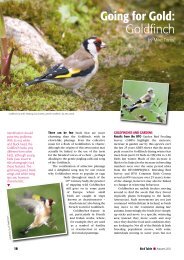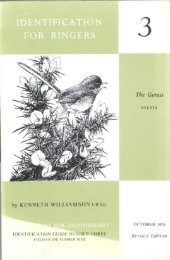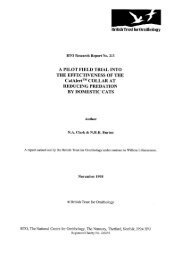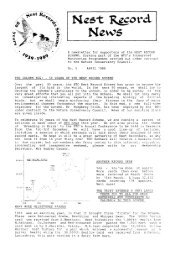Warbler - British Trust for Ornithology
Warbler - British Trust for Ornithology
Warbler - British Trust for Ornithology
Create successful ePaper yourself
Turn your PDF publications into a flip-book with our unique Google optimized e-Paper software.
6 INTRODUCTION<br />
Scope ofthe Work<br />
This is not a <strong>for</strong>mal taxonomic review, and my main purpose<br />
has been to ferret out points which I think: will assist the identification<br />
in the hand of those birds, species or subspecies, which<br />
have even an outside chance ofdrifting to the <strong>British</strong> Isles. It has<br />
nevertheless been necessary to adopt a taxonomic approach, since<br />
at one or two points I have found myself in disagreement with<br />
the most recent review, Charles Vaurie's The Birds ofthe Palearctic<br />
Fauna-a Systematic Reference. This excellent work deals most<br />
competently with relationships and distribution, buthas the drawback<br />
<strong>for</strong> the field-taxonomist that it lacks the plumage descriptions,<br />
wing-<strong>for</strong>mulae and measurements which are fundamental to<br />
correct identification. It should, however, be in the library of<br />
every bird observatory, and access to it cannot but enhance the<br />
competence ofall who trap and ring migrants on any scale. The<br />
reader is referred to this work <strong>for</strong> a full statement ofdistribution,<br />
since only the bare outline is given in the Guide.<br />
I have kept plumage descriptions to a minimum: in the case of<br />
the more familiar birds, adequate data are given in The Handbook<br />
and The Popular Handbook, whilst illustrations can also be found in<br />
the field-guides ,by Peterson, Mount<strong>for</strong>t and Hollom, and Fitter<br />
-and Richardson, to mention a few recent works. For this reason,<br />
more space is allotted to a discussion of the unfamiliar extralimital<br />
<strong>for</strong>ms, and those in which confusion with a commoner<br />
species could arise. In these genera the sexes are alike in plumage;<br />
in general, rst-winter birds are separable from adults, and the<br />
main points of distinction are given. The in<strong>for</strong>mation on the<br />
colours of bill, legs, inside of mouth and iris has been culled<br />
partly from the literature, and partly from collectors' notes on the<br />
labels ofmuseum specimens, written when the birds were freshly<br />
killed. Since the work is intended <strong>for</strong> the use ofthose who handle<br />
birds, I have not added to its bulk by setting down field-characters<br />
(except in a few special cases) but have included references to notes<br />
on this subject in the journals.<br />
Many of these birds have narrow, dark 'fault-barring' across<br />
the tail; such bars arise during the growth ofthe feathers, resulting<br />
from their irregular protrusion from the protecting sheaths, and<br />
their presence is not there<strong>for</strong>e mentioned under the separate<br />
species. In some cases, where it may aid identification, the wing!<br />
tail ratio (or tail-length expressed as a percentage of winglength)<br />
is given under 'Measurements'.<br />
d







